ATI Radeon HD 4350 and 4550: Great HTPC Solutions
by Derek Wilson on September 30, 2008 12:45 AM EST- Posted in
- GPUs
But Can You Really Game on Them?
So the short answer to this quesiton is not really. If you want to play casual games or older games, you'll be fine. Generally, you don't even have to run on the absolute worst settings. But you can't get near the quality even the 9500 GT is capable of delivering (let alone the 4670 which can deliver AA in some cases to low resolution gaming).
With our Crysis test, this time around we looked at everything set to medium quality. While the 4350 and 4550 performed alright at low quality settings, they really can't keep up when it comes to this step up. The 4670 really sticks it to all the other options here.
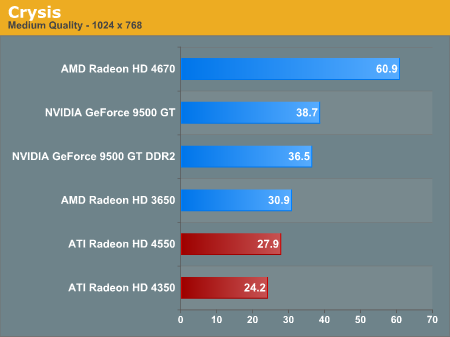
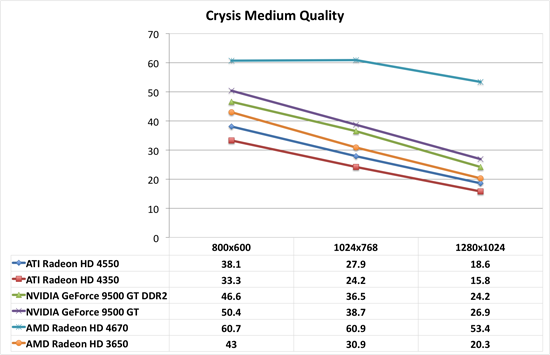
With the way the 4670 pegs the 60fps limit, we wanted to demonstrate just what the advantage can be. Running at our standard High Quality / Very High Shaders settings, it's clear that there is a fundamental difference in the type of performance you get from something like the 4670 and the 4550.
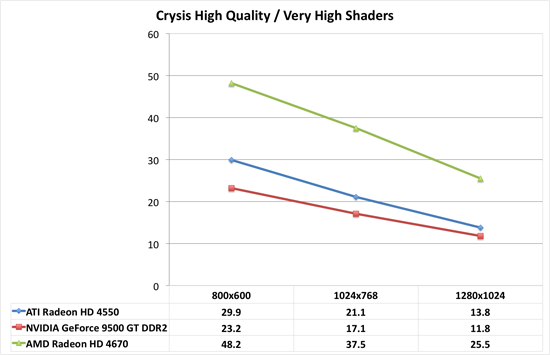
Under Enemy Territory we were actually able to run at the highest quality settings with 4xAA and still get playable performance at 800x600. This isn't that bad, but keep in mind this game is based on an older OpenGL Doom 3 engine. Above 800x600 and we would really need to dial back the settings. Disabling AA goes a long way to boosting framerate, but at these low resolutions it is a shame to lose that feature.
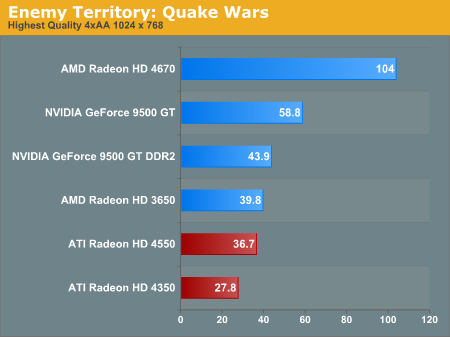

Finally, with Oblivion at our Ultra High defaults setting, we aren't really able to get above 800x600 and remain playable. We would really like to see north of 25fps for a playable experience in Oblivion, and we just can't pull that out at 10x7. Again, even with the advantage the 9500 GT cards have, the gap there pales in comparison to the performance increase shown by when moving to the 4670.
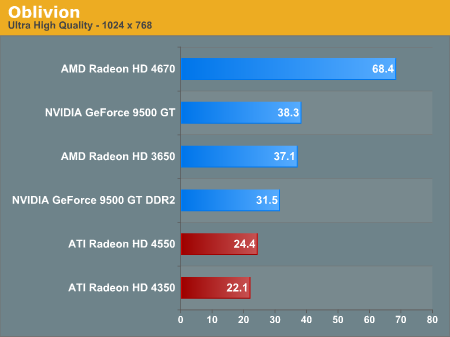

So while these really aren't gaming cards, they do reach up and touch the ability to enable high end settings at the lowest resolution in some cases. On modern games, higher powered options are needed for getting decent quality. But either way, these cards are quite a bit faster than current integrated graphics solutions.










55 Comments
View All Comments
superflex - Tuesday, September 30, 2008 - link
Using a $1450 processor, $240 mobo, $300 RAM and $400 PSU to test a $40 GPU is assanine. That does no service to the HTPC end user.strikeback03 - Tuesday, September 30, 2008 - link
It is their standard graphics test bed, you can't very well make comparisons if you are changing non-tested hardware around.They probably shouldn't have bothered posting anything on these though until they were done with the HTPC portions, judging by all the complaints in the comments.
deruberhanyok - Tuesday, September 30, 2008 - link
Yeah, it would be completely irrational to have a second standard test system for mid-range parts and a third for these lower end ones. I mean, what do you think this is, a tech website?PAPutzback - Tuesday, September 30, 2008 - link
Something along the lines of it being tested in hybrid mode if it is capable with an HTPC type setup. IE, low watt fanless PSU, and low watt processor.The new game should not be benchmarks scores but more about what is the leat wattage I can make a PC and still have all the function of a Media HTPC. No gaming.
I was really disappointed seeing as Anand has a theater blog on the site and this would of been a perfect setup to test along with his theater.
whosthere - Tuesday, September 30, 2008 - link
Derek,You guys published an article on G45 a few days back, then why didn't you show any G45 numbers in this article and still showing the antiquated G35 numbers?
fic2 - Tuesday, September 30, 2008 - link
Looking forward to the article on how well a 4870 runs on an Atom based computer.Got to go google for articles on how well a Landrover does on an F1 track.
What a waste of an article. Best thing that can be said is that trees died for it.
archer75 - Tuesday, September 30, 2008 - link
The ATI cards have problems with some receivers and TV's. It has to do with the EDID and is documented over at avsforums.comThis affects some Onkyo, Denon and Yamaha receivers.
madspartus - Tuesday, September 30, 2008 - link
Honestly why did you pair a $40 graphics card with a qx processor at 3.2 ghz...it just doesnt make any sense.Then showing power consumption differences on that system using a qx processor and 1200W power supply where the power used by the video card is little more than a unmentionable blip.
next time would you try testing it in a system we might actually use this hardware in, like HTPC which you said yourself.
maybe compare the power consumption to an IGP solution...and use a ~300W power supply etc.
All those graphs were of no value to someone who wants to evaluate this thing for HTPC.
duploxxx - Tuesday, September 30, 2008 - link
I agree, keep the review in reality and put this in a 780-790 mobo with x2 6000 or 6500 and an intel p45 with e5xxx - e7xxx series.that would give a realistic platform
Varkyl - Tuesday, September 30, 2008 - link
I would also like to know what kind of temperatures these cards are running at. If they are anything like their big brother 4850 they run very hot. So before I even think about buying one of these I would like to know that it isn't adding an incredible amount of heat to my HTPC.